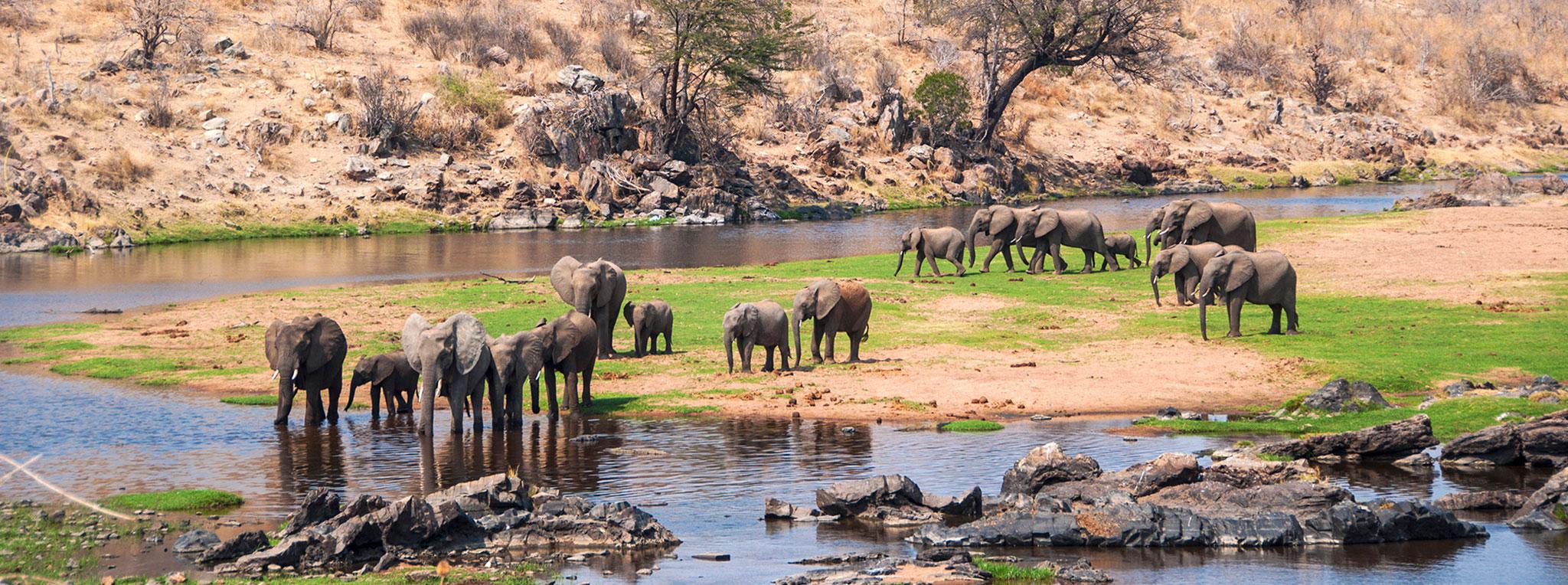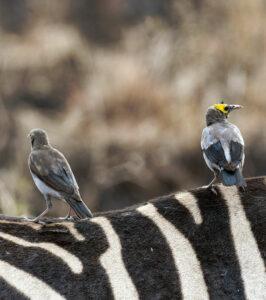Ruaha National Park
20,226 km2 (7,809 mi2)
1964 (National Park) | 2008 (Expanded)
June to November
A paradise for predators
One of the most exciting parks in Tanzania’s South: Ruaha National Park is vast and remote without the tourist numbers of some northern parks. At the same time, it’s home to a very high number of predators from lions and leopards to hyenas and even the rare wild hunting dogs. Ruaha makes for exclusive adventures and rewards those who dare to sway off the beaten track. If you want to experience exclusive safari moments while not sharing sightings with other travellers and you have a bit of a budget, Ruaha is your park.

Ruaha National Park: The top safari destination in Southern Tanzania
In Ruaha National Park, you can experience classic safari adventures without encountering many other travellers and safari vehicles. Famous for its high number of predators, elephants, and varied landscapes, walking safaris and hot air balloon rides. All you have to do is leave the popular northern circuit behind and venture South!
The allure of a Ruaha safari is easy to grasp: It’s a huge national park, covering diverse landscapes which are home to an equally diverse number of wildlife species. Wildlife sightings are phenomenal here! At the same time there are comparably few accommodations available. This, coupled with its location in the remote southern part of Tanzania, many miles away from the popular Serengeti and Ngorongoro Crater means: Very few travellers make it to Ruaha.
What makes Ruaha National Park special?
Excellent wildlife sightings in diverse landscapes with very few tourists around, make for exclusive safari experiences.
Due to its remoteness, Ruaha is very popular with repeat visitors and passionate safari lovers who have been to Tanzania before.
However, if you would like to visit Ruaha, while not missing out on Serengeti and Ngorongoro, you can choose to fly to Ruaha, landing at one of the bush airstrips inside the park.
Vegetation and landscapes
The vegetation in Ruaha National Park differs drastically between flat treeless savannahs, Miombo woodlands, dry bush lands, swamps, and riverine forests. To illustrate, almost 1650 different plant species can be found in the park, creating a one-of-a-kind botanical paradise.
The park is named after the great Ruaha River of which 160 km flow through the park. It is the most distinctive feature of the park and for its residents the most important. Apart from the river the park is well known for its varied scenery – from large open plains to rolling hills, river systems to wetlands and kopjes to mountains.
The Ruaha National Park marks the transition zone where eastern and southern species of flora and fauna overlap. The Great Rift Valley also runs through the park with escarpment walls rising between 50 and 100 m in height. Natural springs associated with the rift valley are scattered throughout the park.
During the dry season, the majestic Ruaha River recedes to nothing more than a few precious waterholes that predators take complete advantage of. Laying silently in wait, knowing that thirst will drive herds of impalas, gazelles, and other antelopes to come drink. Additionally, the riverine vegetation on the shores around the river helps provide enough cover for lions, leopards, cheetahs, wild dogs and hyenas making it the best hunting ground in the park.
Which animals can you see here?
The Ruaha National Park is famous for having one of the highest concentrations of African elephants in East Africa. Hence, huge numbers of up to 200 are often spotted below giant baobab trees. What’s more, the park is also home to both species of kudu (greater and lesser) as well as the majestic sable and roan antelopes both of which are frequently seen.
Ornithologists are also in for a treat as up to 529 species have been sighted in the park. For example, some of the famous birds include the endemic Ruaha red billed hornbill, kingfishers, sunbirds, black collared lovebirds, ashy starlings, ground hornbills, bateleurs, fish eagles and many more.
Activities
Day-time game drives are the main activity in the park and exciting enough if you ask us. However, if you’d like to change your perspective or add a highlight to your trip, you have the option to book a walking safari or a hot air balloon ride – truly special experiences.
Predators
Ruaha is famous for its high number of predators: lions, leopards, hyenas, African hunting dogs & more.
North & South
Across Ruaha, you will find species of both the northern as well as southern hemisphere.
Absolute Remoteness
Far from any major city and even further from the popular northern circuit, Ruaha is very remote.
WHEN TO GO
Best time to go to Ruaha National Park
As with many safari destinations, the dry season is the best time to visit Ruaha National Park. Between end of June and November, the mighty Ruaha River is one of the very few water sources for animals – an ideal area for great wildlife sightings. The weather is sunny and warm, but not too hot and the roads are dry and better to navigate. The rains start earlier than on the Northern Circuit and can begin as early as mid-December and last until March. The rainy season is a great time for birders as many migratory birds can be observed. However, during the rainy low season, some accommodations in Ruaha National Park close temporarily, so good planning is essential.
Dry Season
June to NovemberBest for wildlife sightings at the Ruaha River.
Green Season
December to MayGreat for birding, but dense vegetation can make sightings difficult.
Why to go
Exclusive and remote – perfect for photographers & safari lovers
It takes about four hours to drive from Iringa, a town of about 1 million people, to Ruaha National Park. And more than twice as long from the coastal city of Dar es Salaam. While it’s not exactly easy to reach, this is what makes Ruaha National Park special. It has all the ingredients for a perfect, classic safari: excellent wildlife, varied landscapes, personal accommodations. But less the number of vehicles and tourists you may find in the popular northern parks close to Arusha. If you’re a photographer or simply a passionate safari lover looking for an authentic experience, we recommend considering a trip to Ruaha.


If Ruaha was on the northern circuit it would be one of the most visited parks in Tanzania. I would encourage any safari lover to venture south and experience this special place. Pure remoteness, excellent camps and lodges, first-class safari experiences!Arno | Tanzania Travel Expert
WHERE TO STAY IN RUAHA NATIONAL PARK
Location
Ruaha National Park is located in central southern Tanzania. The closest town of about 1 million people is Iringa, 130km from the national park. Southern Tanzania is very remote and less frequently visited than the better-known parks in the northern region of the country. Therefore, the easiest way to get to Ruaha is to fly in. You can choose between chartered and scheduled flights departing from Dar es Salaam. Alternatively, a ten-hour drive – plus a stopover in between – will get you there.
- Ruaha National Park
- Arusha 780 km | 16 hours by road
- Dar es Salaam 610 km | 13 hours by road
- Serengeti National Park (Naabi Gate) 860 km | 17 hours by road
- Mikumi National Park 310 km | 6 hours by road
- Nyerere (Selous) National Park 570 km | 12 hours by road
- Katavi National Park 900 km | 1 hours 45 minutes by plane



Experience Tanzania with us
Speak to one of our travel experts
Let's start planning your trip!
We will get back to you within 2 working days.
 on Tripadvisor
on Tripadvisor























